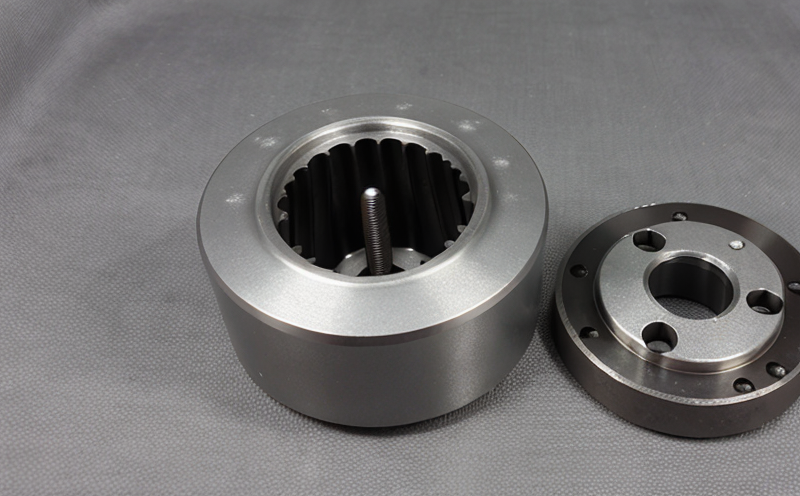ISO 6506 Brinell Hardness of Powder Metallurgy Materials
The ISO 6506 standard for Brinell hardness testing provides a robust method to evaluate the mechanical properties of materials, including those used in powder metallurgy (PM). This test is particularly useful for assessing the hardness and wear resistance characteristics of PM parts that are critical in industries such as aerospace, automotive, and manufacturing. The Brinell hardness number (HB) measures the indentation hardness by pressing a tungsten carbide ball into the surface of a specimen under a specific load.
For powder metallurgy materials, this test is essential for quality assurance and compliance with international standards. It helps ensure that parts meet the required mechanical properties necessary for their intended applications. The Brinell hardness test can be performed on various PM materials like iron-based alloys, copper-based alloys, and nickel-based alloys.
The process involves carefully preparing a sample of the material to be tested. This preparation ensures uniformity across samples and consistency in results. Once prepared, the sample is placed under a testing machine that applies a specified load using a tungsten carbide ball indenter. The hardness number is calculated based on the diameter of the indentation left by the indenter after removal.
The Brinell hardness test is particularly suitable for PM materials because these parts often have complex geometries and may not be conducive to other hardness testing methods like Rockwell or Vickers. This makes it an ideal choice for industries where precision and repeatability are crucial, such as in the aerospace sector where part failure can lead to catastrophic consequences.
Understanding the Brinell hardness of PM materials is vital for ensuring that these parts meet the stringent requirements set by international standards like ISO 6506. This test provides valuable insights into the material's wear resistance and potential durability, which are critical factors in their design and application.
Scope and Methodology
The scope of the ISO 6506 Brinell hardness test for powder metallurgy materials is broad, encompassing a wide range of applications across different industries. The methodology involves several key steps to ensure accurate and reliable results:
- Sample Preparation: Ensuring that the sample is representative of the material's properties.
- Load Application: Applying a specified load to create an indentation with a defined diameter using a tungsten carbide ball indenter.
- Data Collection: Recording the dimensions and depth of the indentation for subsequent calculation of the Brinell hardness number.
- Calibration: Regularly calibrating the testing machine to maintain accuracy over time.
The methodology also includes guidelines for selecting the appropriate indenter size and load based on the material's thickness. This ensures that the test provides meaningful data without causing excessive deformation of the sample, which could lead to inaccurate results.
For powder metallurgy materials, the Brinell hardness test is often performed using a specific range of loads (typically 100 kgf up to 3000 kgf) and indenter diameters. The choice of load depends on the material's thickness and expected hardness range. Proper sample preparation is crucial as it affects the accuracy of the results. Samples must be free from surface defects, inclusions, or other anomalies that could influence the test outcome.
The testing machine used for this method should meet the requirements specified in ISO 6506 to ensure consistent and accurate measurements. Regular maintenance and calibration are essential to maintain the integrity of the results over time. The use of appropriate indenter diameters (e.g., 10 mm, 2.5 mm) allows for precise indentation without causing excessive deformation.
Why Choose This Test
The ISO 6506 Brinell hardness test is a cornerstone of quality assurance in the powder metallurgy industry. By ensuring that materials meet specified hardness requirements, this test helps prevent costly errors and failures in critical applications.
For industries like aerospace and automotive, where reliability and safety are paramount, accurate hardness testing is essential. The test provides valuable data on wear resistance and potential durability, which are crucial factors in the design and application of PM parts.
The Brinell hardness number (HB) serves as a standardized measure that allows for consistent comparisons across different materials and manufacturers. This standardization ensures uniform quality across production batches, reducing variability and ensuring that products meet industry standards like ISO 6506.
By choosing this test, organizations can maintain high levels of product quality and customer satisfaction while complying with international standards. The test's accuracy and reliability make it an invaluable tool for R&D engineers, compliance officers, and quality managers looking to ensure the integrity of their products.





